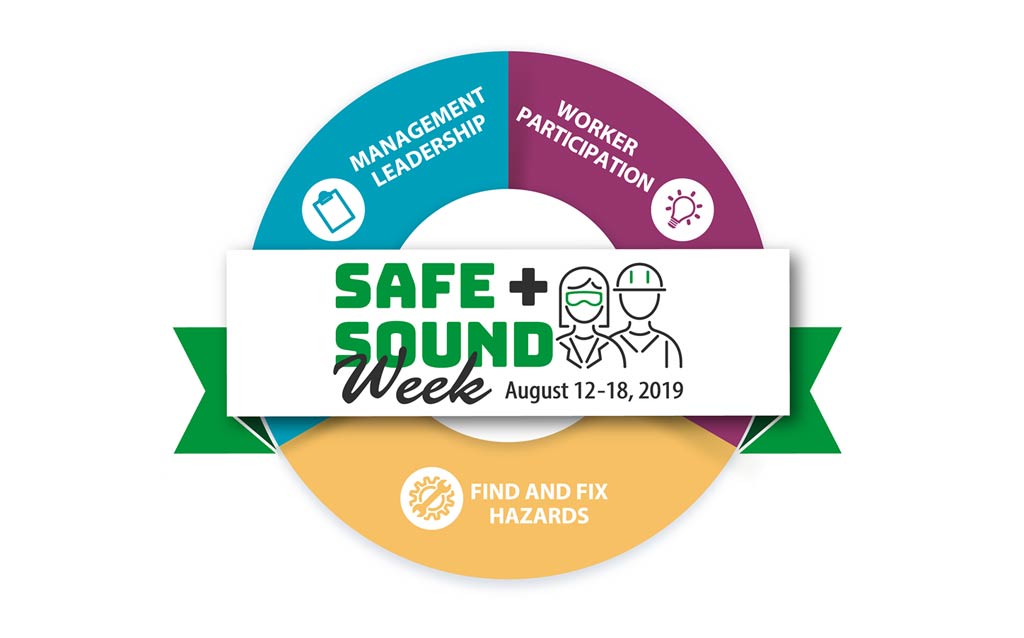According to the U.S. Bureau of Labor Statistics, every year more than 5,000 workers are killed on the job (a rate of 14 per day), and more than 3.6 million suffer a serious job-related injury or illness.
Serious job-related injuries or illnesses don’t just hurt workers and their families, but can hurt business in a variety of ways. Implementing a safety and health program, however, can improve small- and medium-sized businesses’ safety and health performance, save money, and improve competitiveness.
OSHA’s Safe + Sound Week is a nationwide campaign to raise awareness and understanding of the value of proactive occupational safety and health (OSH) programs in all workplaces. Safe + Sound is a year-round campaign to encourage every workplace to have a safety and health program.
 Image Source: Shutterstock
Image Source: Shutterstock Why Is Safety Important?
Traditional approaches to finding and fixing workplace hazards are often reactive. Actions are taken only after a worker is injured or becomes sick, a new standard or regulation is published, or an outside inspection finds a problem that must be fixed. Finding and fixing hazards using a proactive approach, before they cause injury or illness, is far more effective.
OSHA Flyer: 10 Ways to get Your Program Started (PDF)
Workplaces are always evolving as new technologies, processes, materials, and workers are introduced. By adopting a systematic approach, businesses can stay on top of emerging hazards that could lead to injury or illness. Discover 10 ways to get started your Safe and Sound program started:
https://www.osha.gov/safeandsound/docs/SHP_10-Ways-to-Get-Started.pdf
.A safety and health program is a proactive way to manage hazards in the workplace to prevent injuries and illnesses. Several program models are available for employers to follow, including OSHA’s Recommended Practices for Safety and Health Programs , NSC’s Journey to Safety Excellence, ANSI Z-10, or international standards such as ISO 45001.
Safety and health programs help businesses:
- Prevent workplace injuries and illnesses
- Improve compliance with laws and regulations
- Reduce costs, including significant reductions in workers’ compensation premiums
- Engage workers
- Enhance social responsibility goals
- Increase productivity and enhance overall business operations

Why Participate in Safe + Sound Week?
Safe workplaces are sound businesses. Successful safety and health programs can proactively identify and manage workplace hazards before they cause injury or illness, improving sustainability and the bottom line. Participating in Safe + Sound Week can help get your program started or energize an existing one.
Who Is Encouraged to Participate Safe + Sound Week?
Organizations of any size or in any industry looking for an opportunity to show their commitment to safety to workers, customers, the public, or supply chain partners should participate.
How to Participate in Safe + Sound Week
Participating in Safe + Sound Week is easy. To get started, select the activities you would like to do at your workplace. You can host an event just for your workers or host a public event to engage your community. Examples of potential activities and tools to help you plan and promote your events are available. After you’ve completed your events, you can download a certificate and web badge to recognize your organization and your workers.
Need more inspiration? Watch a webinar to get ideas from organizations that participated in last year’s event.
OSHA Outreach Training provides instruction and training on the recognition, avoidance, abatement, and prevention of workplace hazards. The OSHA Training Program also provides an overview of OSHA, regarding workers’ rights, employer responsibilities, and how to file a complaint.
- Know Your Rights! Under federal law, you are entitled to a safe workplace.
- Training provides details on OSHA, workplace hazards, workers’ legal rights, employer responsibilities, and how to file a complaint. Required by some states and companies in order to start employment.
- DOL Plastic Card Shipped Within 2 Weeks
- Reg. Price: 10hr: $89 - 30hr: $189
- Enter Promo Code "osha15off" at Checkout
Why is Health and Safety Training Important?
Aside from the obvious benefit of keeping employees safe, healthy, and productive – along with meeting the OSHA workplace safety standards – health and safety training makes financial sense for employers because:
- Every dollar spent on proper health and safety programs can save a business $4 to $6! [1]
- With less work-related illnesses and injuries, employers see significant savings on absenteeism and workers’ compensation insurance. [2]
- According to one study by California’s Division of Occupational Safety and Health (Cal/OSHA), businesses inspected by OSHA “saved an estimated $355,000 in injury claims and compensation paid for lost work” in the four years after inspections. [3]
- Businesses that meet OSHA’s standards avoid inspection violations and possible fines.
 Image Source: Shutterstock
Image Source: Shutterstock
Employer Reasons for a Workplace Health and Safety Program
Here are a few reasons why you should give strong consideration to a health and safety training program:
- All Workplaces Have an Element of Risk – From manually handling packages to driving heavy machinery, there are different levels of exposure to risk and illness.
- Increases Staff Productivity – Employees in many ways are like customers, treat them well and they stay, treat them well and they feel valued and treat your customers well in turn.
- Reduces Frequency of Compensation Claim or Lawsuit – It only takes one serious injury to bring a worker’s compensation claim or lawsuit. Safety training can diminish the frequency.
- Enhances Company Image Positively – Workers want to know what they stand to gain from a company in regards their benefits and salaries, but they also want to know your plan for their health and safety.
- Reduces Costs – Apart from the cost that will be accrued by litigation costs, fines and compensation payments, actual injuries and incidents can rack up direct costs in, medical expenses such as ambulance, hospital, and doctors’ fees, medication, and rehabilitation. There could even be increases in insurance premiums as a result. Likewise, indirect costs could include disrupted work schedules, lost productivity, clean-up and repair, hiring and training replacement workers, bad publicity, time spent on accident investigation and claims management.
As an employer, don’t think health and safety training is expensive and wasteful. Health and safety training educates your workers to work safely and motivates them to be more productive… which is a profit in itself.
Additional Resources – Ebooks
Employer Rights and Responsibilities Following an OSHA Inspection
(OSHA 3000 – 2018) (English: EPUB MOBI PDF Add to Cart)
(OSHA 3195 – 2018) (Spanish: EPUB MOBI PDF Add to Cart)
Fall Prevention: Training Guide – A Lesson Plan for Employers
(OSHA 3666 – 2014) (English: EPUB MOBI PDF)
(OSHA 3727 – 2014) (Spanish: EPUB MOBI PDF)
Fire Service Features of Buildings and Fire Protection Systems
Explains how fire service operations can be influenced by different building features and offers considerations for design professionals that can help facilitate these operations. The manual includes chapters and narratives on building and site design, sprinkler systems, standpipe systems, fire department connections, fire alarm and communications systems, as well as various firefighting systems.
(OSHA 3256 – 2015) (English: EPUB MOBI PDF)
General Industry Digest
(OSHA 2201 – 2015) (English: EPUB MOBI PDF)
Hazard Communication: Small Entity Compliance Guide for Employers That Use Hazardous Chemicals
(OSHA 3695 – 2014) (English: EPUB MOBI PDF)
Ladder Safety: Falling Off Ladders Can Kill: Use Them Safely
(OSHA 3625 – 2015) (English: EPUB MOBI PDF)
(OSHA 3625 – 2015) (Spanish: EPUB MOBI PDF)
Nail Gun Safety: A Guide for Construction Contractors
(OSHA 3459 – 2011) (English: EPUB MOBI PDF)
(OSHA 3505 – 2012) (Spanish: EPUB MOBI PDF Add to Cart)
Nail Salon Workers: Stay Healthy and Safe While Giving Manicures and Pedicures
(OSHA 3542 – 2012) (English: EPUB MOBI PDF Add to Cart)
(OSHA 3559 – 2013) (Korean: EPUB MOBI PDF Add to Cart)
(OSHA 3560 – 2012) (Spanish: EPUB MOBI PDF Add to Cart)
(OSHA 3558 – 2012) (Vietnamese: EPUB MOBI PDF Add to Cart)
Poultry: Prevention of Musculoskeletal Disorders in Poultry Processing (Updated Guidelines)
(OSHA 3213 – 2013) (English: EPUB MOBI PDF Add to Cart)
(OSHA 3749 – 2014) (Spanish: EPUB MOBI PDF Add to Cart)
Respiratory Protection: NIOSH/OSHA/CDC Hospital Respiratory Protection Program Toolkit
(OSHA 3767 – 2015) (English: DOC EPUB MOBI PDF)
Training Requirements in OSHA Standards
(OSHA 2254 – 2015) (English: EPUB MOBI PDF)
Tree Care Work Hazards – Hazard Bulletin
(OSHA HB 3731 – 2014) (English: EPUB HTML MOBI PDF Add to Cart)
(OSHA HB 3740 – 2014) (Spanish: EPUB HTML MOBI PDF Add to Cart)
Workplace Violence: Guidelines for Preventing Workplace Violence for Healthcare and Social Service Workers
(OSHA 3148 – 2016) (English: EPUB MOBI PDF)
